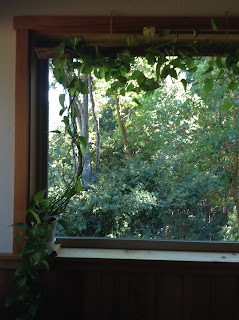Several days later I saw a little frog sitting between the plant and the window frame, two or three inches long, green and spotted, with a whitish stripe down his side. He was so handsome I wanted to kiss him.
I didn't see him again for several days. Then, peering into the pot, I saw two eyes in the dirt. When my vision adjusted, I saw a very muddy frog well camouflaged in a scooped-out hollow under the plant. That's where he had been hiding!
How he got to my bedroom is a mystery. It seems unlikely he hopped up the stairs (tiny frog, big steps) and then just happened to find such a good living place. Such luck happens only in fairy tales. Why would he come up the stairs in the first place? Maybe the frog was in the plant when my friend gave it to me, but that doesn't seem likely, either, since I have had the plant for a year. The frog's mysterious appearance is reason enough to try the kissing, especially since he chose the bedroom for his home. Isn't that what you would expect a prince to do?
Even in frog form, he was a good companion. He never left another turd on the windowsill. Just knowing he was there, I spoke to him whenever I came into the room. "Hi, frog. How are you doing?" He was in a good environment – a warm windowsill, moist dirt under the plant, flies to catch for food, and plenty of water from the plastic container the pot of devil's ivy sat in.
He was undeniably a beautiful frog, once outside the mud. I understood how the fairy tale got started – except, no. The princess didn't kiss the frog because he was handsome. The point of the tale is that the princess was gracious enough to kiss something very ugly but very kind.
Yesterday I saw my handsome frog splayed out against the clear plastic of the water container, seemingly pressed between it and the ceramic pot of the devil's ivy. His throat was throbbing. The next day he was still there, his throat still pulsing against the clear plastic. When he was still there the next day, I became worried that he had somehow gotten so tightly squeezed in place he couldn't jump out. His throat was still pulsing, but he hadn't moved his position.
Maybe he needed help. Maybe he wasn't in the best environment, after all. Maybe I should give him a new home. So I removed the ceramic pot with its plant from the plastic container and quickly covered the container with a cloth before the frog could hop out. I carried him downstairs and out to the deck and released him in the pot of a dahlia.
I haven't seen him since. None of the dirt under the dahlia is hollowed out. I'm sure he's happy somewhere else, and I'm glad I gave him back to the outdoors because, after all, wild animals belong in the wild. Fairy tales were written by human beings; their morals reveal a human point of view. I didn't feel right keeping a frog as a captured pet any more than I would have a wolf or a lynx or a python. Wild animals belong in the wild.
Nevertheless, I miss my frog.







